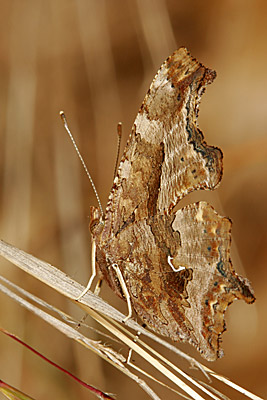|
Eastern Comma (Polygonia comma) |
  |
| County | State | Date | County | State | Date | |||
| Canadian | OK | 07/2005 | Oklahoma | OK | 07/2005 |
|
Eastern Comma (Polygonia comma) |
  |
| County | State | Date | County | State | Date | |||
| Canadian | OK | 07/2005 | Oklahoma | OK | 07/2005 |
Identification: Small with short
hindwing
projections.
Forewing above is brownish-orange with dark spots; one dark spot at
center of bottom edge.
Hindwing above has two patterns: summer form is mostly black, winter
form is orange with black spots; both have a dark border containing pale spots.
Underside is brown;
hindwing with a central silver or white comma which is swollen at both
ends.
Flight: Overwintered adults fly and lay eggs in the spring until
the end of April. The summer form emerges and flies from May-September, laying
eggs that develop into the winter form. These adults appear in September or
October and soon seek shelter in which to
overwinter.
Wing span: 1 3/4 - 2 1/2 inches (4.5 - 6.4 cm).
Caterpillar hosts: All members of the elm and nettle families including
American elm (Ulmus americana), hops (Humulus), nettle (Urtica), false nettle (Boehmeria
cylindrica), and wood nettle (Laportea canadensis).
Adult food: Rotting fruit and tree sap.
Habitat: Deciduous woodlands; woods near rivers, marshes, swamps, and
other water sources.
Range: Eastern half of the United States east of the Rocky Mountains from
southern Canada to central Texas and the Gulf Coast.